An online project under the direction of the CAPE ANN MUSEUM
inv. 265
Ships Leaving Boston Harbor
Boston Harbor
1847 Oil on canvas 20 x 30 in. (50.8 x 76.2 cm) Signed and dated lower left: F.H. Lane 1847
|
Explore catalog entries by keywords view all keywords »
Historical Materials
Below is historical information related to the Lane work above. To see complete information on a subject on the Historical Materials page, click on the subject name (in bold and underlined).
U.S. Coast Pilot, Atlantic Coast Part 3.
Government Printing Office, Washington, D.C.
Detail of Coast Pilot chart showing Point Allerton.
Filed under: Boston Harbor »
During the years after the war of 1812 and before the Civil War, the port of Boston was a center of American deep-water shipping. Trading with China, India, and the West Indies, which had fueled maritime growth in the early years of the century gave way to re-exporting these goods and foreign trade based on the shoe and textile trades. Although second to New York in terms of shipping tonnage, many of New York's shipbuilders and merchants were Boston based. In addition, ship building continued in Boston. Also, the coastal trade (the domestic trade up and down the coast) was still the most efficient way to transport goods and passengers, and accounts for much of the tonnage and shipping traffic.
Although dwarfed by New York, Boston was an active port in the 1840s and 1850s. Its registered tonnage rose from 149,186 in 1840 to 270,510 in 1850. The harbor was a crowded place. For example, on September 18, 1850, 32 ships, 49 barks, 47 brigs, and 52 schooners were reported at Boston.(1)
In 1849, foreign entries at Boston included 215 ships, 305 barks, 908 brigs, and 52 schooners. Coastwise arrivals included 193 ships, 488 barks, 1087 brigs, 4287 schooners, 89 sloops, and 65 schooners.(2)
(1) W.H. Bunting, p.8.
(2) Ibid.
For more information:
Samuel Eliot Morrison, The Maritime History of Massachusetts, 1783-1860
W.H. Bunting, Portrait of a Port, Boston 1852-1914 Cambridge: The Belknap Press of Harvard University, 1971.
Printed map inside Boston Almanac
Published by B. B. Mussey & Co. and Thomas Groom, Boston
Cape Ann Museum Library & Archive (R910.45 B65 1848)
Map at front of almanac with Tremont Temple highlighted.
Also filed under: Boston City Views » // Maps » // Tremont Temple »
Harvard Depository: Widener (NAV 578.57)
For digitized version, click here.
Also filed under: Signal Systems (Flags & Maritime Codes) »
Tinted lithograph with hand coloring
13 7/8 x 22 3/8 in.
Boston Athenaeum
From Sally Pierce and Catharina Slautterback, Boston Lithography, 1825–1880: The Boston Atheneaum Collection (Boston: Athenaeum, 1991): "Tidd drew this print when he was a consulting engineer for Simpson's. He has depicted the clipper ship 'Southern Cross' in the dry dock. Built in 1851, she was known for having sailed from San Francisco to Hong Kong in the record breaking time of thirty-two days. The Bethlehem Ship Building Company eventually took over this location and operated a dry dock there until the mid 1940s."
Also filed under: "Southern Cross" (Clipper Ship) » // M. M. Tidd, Lith. – Boston »
Library of Congress Catalog Number 2004671768
Also filed under: "Britannia" (Cunard Steamship) »
1853
Bostonian Society (1884.0209)
Also filed under: Scott, John W. A. »
1 print : lithograph, tinted ; image 50.3 x 111.9 cm., 68.7 x 121.2 cm.
View of the city of Boston from East Boston showing Boston Harbor. The wharves of East Boston can be seen in the foreground.
Number nine of thirty-eight city views published in "Whitefield's Original Views of (North) American Cities (Scenery).
On stone by Charles W. Burton after a drawing by Edwin Whitefield.
Inscribed in brown ink lower right corner of sheet: "Boston Athenaeum from Josiah Quincy. September 28, 1848."
Local Notes:#1848.1.
In general, brigs were small to medium size merchant vessels, generally ranging between 80 and 120 feet in hull length. Their hull forms ranged from sharp-ended (for greater speed; see Brig "Antelope" in Boston Harbor, 1863 (inv. 43)) to “kettle-bottom” (a contemporary term for full-ended with wide hull bottom for maximum cargo capacity; see Ships in Ice off Ten Pound Island, Gloucester, 1850s (inv. 44) and Boston Harbor, c.1850 (inv. 48)). The former were widely used in the packet trade (coastwise or transoceanic); the latter were bulk-carriers designed for long passages on regular routes. (1) This rig was favored by Gloucester merchants in the Surinam Trade, which led to vessels so-rigged being referred to by recent historians as Surinam brigs (see Brig "Cadet" in Gloucester Harbor, late 1840s (inv. 13) and Gloucester Harbor at Dusk, c.1852 (inv. 563)). (2)
Brigs are two-masted square-rigged vessels which fall into three categories:
Full-rigged brigs—simply called brigs—were fully square-rigged on both masts. A sub-type—called a snow—had a trysail mast on the aft side of the lower main mast, on which the spanker, with its gaff and boom, was set. (3)
Brigantines were square-rigged on the fore mast, but set only square topsails on the main mast. This type was rarely seen in America in Lane’s time, but was still used for some naval vessels and European merchant vessels. The term is commonly misapplied to hermaphrodite brigs. (4)
Hermaphrodite brigs—more commonly called half-brigs by American seamen and merchants—were square-rigged only on the fore mast, the main mast being rigged with a spanker and a gaff-topsail. Staysails were often set between the fore and main masts, there being no gaff-rigged sail on the fore mast.
– Erik Ronnberg
References:
1. Howard I. Chapelle, The National Watercraft Collection (Washington, DC: Smithsonian Institution, 1960), 64–68.
2. Alfred Mansfield Brooks, Gloucester Recollected: A Familiar History (Gloucester, MA: Peter Smith, 1974), 62–74. A candid and witty view of Gloucester’s Surinam Trade, which employed brigs and barks.
3. R[ichard] H[enry] Dana, Jr., The Seaman's Friend (Boston: Thomas Groom & Co., 1841. 13th ed., 1873), 100 and Plate 4 and captions; and M.H. Parry, et al., Aak to Zumbra: A Dictionary of the World's Watercraft (Newport News, VA: The Mariners’ Museum, 2000), 95.
4. Parry, 95, see Definition 1.
Oil on canvas
17 1/4 x 25 3/4 in.
Cape Ann Museum, Gloucester, Mass., Gift of Isabel Babson Lane, 1946 (1147.a)
Photo: Cape Ann Museum
Detail of brig "Cadet."
Also filed under: "Cadet" (Brig) »
Painting on board
72 x 48 in.
Collection of Erik Ronnberg
Chart showing the voyage of the brig Cadet to Surinam and return, March 10–June 11, 1840.
Also filed under: "Cadet" (Brig) » // Surinam Trade »
Hermaphrodite brigs—more commonly called half-brigs by American seamen and merchants—were square-rigged only on the fore mast, the main mast being rigged with a spanker and a gaff-topsail. Staysails were often set between the fore and main masts, there being no gaff-rigged sail on the fore mast. (1)
The half-brig was the most common brig type used in the coasting trade and appears often in Lane’s coastal and harbor scenes. The type was further identified by the cargo it carried, if it was conspicuously limited to a specialized trade. Lumber brigs (see Shipping in Down East Waters, 1854 (inv. 212) and View of Southwest Harbor, Maine: Entrance to Somes Sound, 1852 (inv. 260)) and hay brigs (see Lighthouse at Camden, Maine, 1851 (inv. 320)) were recognizable by their conspicuous deck loads. Whaling brigs were easily distinguished by their whaleboats carried on side davits (see Ships in the Harbor (not published)). (2)
– Erik Ronnberg
References:
1. M.H. Parry, et al., Aaak to Zumbra: A Dictionary of the World's Watercraft Newport News, VA: The Mariners’ Museum, 2000), 268, 274; and A Naval Encyclopaedia (L.R. Hamersly & Co., 1884. Reprint: Detroit, MI: Gale Research Company, 1971), 93, under "Brig-schooner."
2. W.H. Bunting, An Eye for the Coast (Gardiner, ME: Tilbury House: 1998), 52–54, 68–69; and W.H. Bunting, A Day's Work, part 1 (Gardiner, ME: Tilbury House: 1997), 52.
Schooners in Lane’s time were, with few exceptions, two-masted vessels carrying a fore-and-aft rig having one or two jibs, a fore staysail, gaff-rigged fore- and main sails, and often fore- and main topsails. One variant was the topsail schooner, which set a square topsail on the fore topmast. The hulls of both types were basically similar, their rigs having been chosen for sailing close to the wind. This was an advantage in the coastal trade, where entering confined ports required sailing into the wind and frequent tacking. The square topsail proved useful on longer coastwise voyages, the topsail providing a steadier motion in offshore swells, reducing wear and tear on canvas from the slatting of the fore-and-aft sails. (1)
Schooners of the types portrayed by Lane varied in size from 70 to 100 feet on deck. Their weight was never determined, and the term “tonnage” was a figure derived from a formula which assigned an approximation of hull volume for purposes of imposing duties (port taxes) on cargoes and other official levies. (2)
Crews of smaller schooners numbered three or four men. Larger schooners might carry four to six if a lengthy voyage was planned. The relative simplicity of the rig made sail handling much easier than on a square-rigged vessel. Schooner captains often owned shares in their vessels, but most schooners were majority-owned by land-based firms or by individuals who had the time and business connections to manage the tasks of acquiring and distributing the goods to be carried. (3)
Many schooners were informally “classified” by the nature of their work or the cargoes they carried, the terminology coined by their owners, agents, and crews—even sometimes by casual bystanders. In Lane’s lifetime, the following terms were commonly used for the schooner types he portrayed:
Coasting schooners: This is the most general term, applied to any merchant schooner carrying cargo from one coastal port to another along the United States coast (see Bar Island and Mt. Desert Mountains from Somes Settlement, 1850 (inv. 401), right foreground). (4)
Packet schooners: Like packet sloops, these vessels carried passengers and various higher-value goods to and from specific ports on regular schedules. They were generally better-maintained and finished than schooners carrying bulk cargoes (see The Old Fort and Ten Pound Island, Gloucester, 1850s (inv. 30), center; and Gloucester Inner Harbor, 1850 (inv. 240), stern view). (5)
Lumber schooners: Built for the most common specialized trade of Lane’s time, they were fitted with bow ports for loading lumber in their holds (see View of Southwest Harbor, Maine: Entrance to Somes Sound, 1852 (inv. 260)) and carried large deck loads as well (Stage Rocks and the Western Shore of Gloucester Outer Harbor, 1857 (inv. 8), right). Lumber schooners intended for long coastal trips were often rigged with square topsails on their fore masts (see Becalmed Off Halfway Rock, 1860 (inv. 344), left; Maverick House, 1835 (not published); and Lumber Schooner in a Gale, 1863 (inv. 552)). (6)
Schooners in other specialized trades. Some coasting schooners built for carrying varied cargoes would be used for, or converted to, special trades. This was true in the stone trade where stone schooners (like stone sloops) would be adapted for carrying stone from quarries to a coastal destination. A Lane depiction of a stone schooner is yet to be found. Marsh hay was a priority cargo for gundalows operating around salt marshes, and it is likely that some coasting schooners made a specialty of transporting this necessity for horses to urban ports which relied heavily on horses for transportation needs. Lane depicted at least two examples of hay schooners (see Gloucester Harbor, 1850s (inv. 391), left; and Coasting Schooner off Boon Island, c.1850 (inv. 564)), their decks neatly piled high with bales of hay, well secured with rope and tarpaulins.
– Erik Ronnberg
References:
1. Howard I. Chapelle, The History of American Sailing Ships (New York: W.W. Norton & Co., 1935), 258. While three-masted schooners were in use in Lane’s time, none have appeared in his surviving work; and Charles S. Morgan, “New England Coasting Schooners”, The American Neptune 23, no. 1 (DATE): 5–9, from an article which deals mostly with later and larger schooner types.
2. John Lyman, “Register Tonnage and its Measurement”, The American Neptune V, nos. 3–4 (DATE). American tonnage laws in force in Lane’s lifetime are discussed in no. 3, pp. 226–27 and no. 4, p. 322.
3. Ship Registers of the District of Gloucester, Massachusetts, 1789–1875 (Salem, MA: The Essex Institute, 1944). Vessels whose shipping or fishing voyages included visits to foreign ports were required to register with the Federal Customs agent at their home port. While the vessel’s trade or work was unrecorded, their owners and master were listed, in addition to registry dimensions and place where built. Records kept by the National Archives can be consulted for information on specific voyages and ports visited.
4. Howard I. Chapelle, The National Watercraft Collection (Washington, DC: Smithsonian Institution, 1960), 40, 42–43.
5. Ibid., 42–43, 73.
6. Ibid., 74–76.
A topsail schooner has no tops at her foremast, and is fore-and-aft rigged at her mainmast. She differs from an hermaphrodite brig in that she is not properly square-rigged at her foremast, having no top, and carrying a fore-and-aft foresail instead of a square foresail and a spencer.
Wood rails, metal rollers, chain; wood cradle. Scale: ½" = 1' (1:24)
Original diorama components made, 1892; replacements made, 1993.
Cape Ann Museum, from Gloucester Chamber of Commerce, 1925 (2014.071)
A schooner is shown hauled out on a cradle which travels over racks of rollers on a wood and metal track.
Also filed under: Burnham Brothers Marine Railway » // Marine Railways »
Glass plate negative
Collection of Erik Ronnberg
Also filed under: Lobstering »
Details about Maine's lumber trade in 1855, see pp. 250–52
Also filed under: Castine » // Lumber Industry »
Sloops are one-masted sailing vessels which, in American examples, set fore-and-aft sails but usually no square sails. Thus, staysails, or jibs, are set from the fore stay(s) and a quadrilateral mainsail is set from the mast and spread by a gaff and a boom. The larger sloops would often set a triangular topsail over the main sail. (1)
The sloops depicted by Lane were used in various coastal trades, each with its own requirements, which dictated the sizes and details of their hulls and rigs. Most elegant were the packet sloops, which transported passengers, mail, and higher value goods between specific ports on regular schedules. They usually measured between sixty and seventy-five feet on deck, as dictated by anticipated shipping volume. Finely finished, they usually had stern galleries—a row of windows across the transom with ornamental moldings—and varied color schemes. Examples of packet sloops are in Gloucester Harbor from Rocky Neck, 1844 (inv. 14) (center, middle ground) and Study of Ships, 1851 (inv. 141) (foreground), both of which probably made trips between Gloucester and Boston, or Gloucester and Newburyport. (2)
Another specialized sloop of similar size was the stone sloop, used to ship granite blocks from stone-loading piers around Cape Ann to other ports. They were similar in rig to packet sloops, but of heavier construction with greater hold capacity and absence of decoration. Their stout appearance was augmented by simple color schemes, or even tarred topsides, reflecting the wear and strain imposed by their heavy cargos. Lane depicted these vessels in his painting of Fresh Water Cove from Dolliver's Neck, Gloucester, Early 1850s (inv. 45), with a sloop (at left) preparing to load at wharf-side, and another (at right) sailing out with a cargo. (3)
Sloops of the more work-a-day sort are the most commonly seen examples in Lane’s paintings, most of them appearing in his views of Boston Harbor. Usually deep-loaded and looking weather-worn, they contrast sharply with the packet- and clipper ships which dominate the scene. Sloops of this type are rarely seen in Lane’s paintings of Gloucester Harbor and the Maine coast, although they were certainly needed for short-distance transportation (see Bear Island, Northeast Harbor, 1855 (inv. 24), View of Camden Mountains from Penobscot Bay, c.1852 (inv. 207), Sunrise on the Maine Coast, Mount Desert Island, 1856 (inv. 295)). For coastal Maine, lack of railroads for heavier freight and greater distances between ports made the use of schooners with larger carrying capacity a greater necessity. (4)
In Lane’s views of New York Harbor, a regional sloop variant, the Hudson River Sloop, appears in New York Harbor, c.1855 (inv. 46) (bow view, left) and A Calm Sea, c.1860 (inv. 6) (stern view, right). This type had become prominent in the Hudson River packet trade between New York City, Albany, and beyond to points north and west as far as the eastern terminus of the Erie Canal. Large vessels for their rigs, they were well-finished and well-kept, reflecting pride of ownership and rivalry among their owners and crews. (5)
– Erik Ronnberg
References:
1. A Naval Encyclopaedia (Philadelphia: L.R. Hamersly & Co., 1884. Reprint: Detroit, MI: Gale Research Company, 1971), 59. See first definition of "sloop" and definition of "sloop-rigged."
2. Robert Greenhalgh Albion, William A. Baker, and Benjamin Woods Labaree, New England and the Sea (Mystic, CT: Mystic Seaport Museum, 1972; reprinted in 1994), 127–28.
3. Howard I. Chapelle, The History of American Sailing Ships (New York: W.W. Norton & Co., 1935), 300–02.
4. Ibid., 300.
5. Ibid., 298–300.
A Naval Encyclopaedia:
Dictionary of nautical words and phrases
Special Articles on Naval Art and Science
Philadelphia: L.R. Hamersly & Co.
'Mudian, "Mugian, or Bermudian. A boat special to the Bermuda islands, usually decked, with the exception of a hatch; from 2 to 20 tons burden; it is short, of good beam, and great draft of water abaft, the stem and keel forming a curved line. It carries an immense quantity of ballast. Besides a long main- and short jib-boom, it has a long, taperking, raking mast, stepped just over the forefoot, generally unsupported by shrouds or stays; on it a jib-headed mainsail is hoisted to a height of twice, and sometimes three times, the length of the keel. This sail is triangular, stretched at its foot by a long boom. The only other sail is a small foresail or jib. They claim to be the fastest craft in the world for working to windward in smooth water, it being recorded of one that she made five miles dead to windward in the hour during a race; and though they may be laid over until they fill with water, they will not capsize.
St. George's Historical Society
Detail of painting of St. George's Harbour, Bermuda, during US Civil War, with a Confederate blockade runner anchored in the foreground.
Also filed under: Puerto Rico »
Wood, metal, cordage, cloth, paint.
Scale: ¼ in. = 1ft. (1:48)
Cape Ann Museum. Gift of Roland and Martta Blanchet (1997.17.3)
Although built in 1890 and larger than the stone sloops of Lane’s time, the "Albert Baldwin’s" hull form, rig, and loading boom are very similar to those of the 1840s and 1850s.
Also filed under: Granite Quarrying / Shipping » // Ship Models »
Yachts and yachting in ninteenth-century America were the preserve of the wealthy, and in Lane's early career were just beginning to organize as yacht clubs with scheduled regattas. The New York Yacht Club, founded in 1844, was the first such organization and had few rival clubs for racing or cruising until after the Civil War. (1) In Boston, by contrast, yachts of any size were few. Instead of regattas, competition was in the form of match races, between two vessels, with cash prizes as a substitute for trophies. Often, the only serious competition for a Boston-owned yacht was one of the crack pilot schooners, and it was not uncommon for a yacht to be sold for pilot service or vice-versa. (2)
If Lane had opportunity to portray any yachts in Boston, only his depiction of schooner "Northern Light" (see The Yacht "Northern Light" in Boston Harbor, 1845 (inv. 268)) has been found to date, and that was based on a drawing by Robert Salmon. (3) It seems likely that he would have depicted more Boston yachts, some of which images might still exist in private collections not currently accessible. For more depictions of yachts by Lane, we must look to New York.
Lane is known to have made two paintings of the schooner yacht "America." The more familiar one The Yacht "America" Winning the International Race, 1851 (inv. 255) was based on a lithograph derived from a painting by Oswald Brierly who witnessed and sketched "America" as she raced for the trophy that now bears her name. (4)
The other painting Yacht "America" from Three Views, c.1851 (inv. 395) was very possibly based on sketches of the designer's half-model, or even the actual vessel under construction. In either case, Lane's drawings and any notes would have been made before the hull and deck details were finalized. (5)
It would not be until August 8, 1856 that Lane would see and sketch a major yacht regatta—held by the New York Yacht Club at New Bedford, Massachusetts. From this event, he painted four known views, each depicting a different moment in the race. The earliest New York Yacht Club Regatta (3), After 1856 (inv. 396) shows the yachts under way to the starting line, with the smallest yachts (third class) starting at 10:50 a.m. The second class would start at 10:55 a.m. and the first (largest yachts) at 11:00 a.m. The second view New York Yacht Club Regatta (2), 1856 (inv. 270) shows the start of the first class; the third New York Yacht Club Regatta (4), 1857 (inv. 397), the race after the start with the large sloops and schooners taking the lead. The fourth New York Yacht Club Regatta (1), 1856 (inv. 66), depicting the finish, shows the winning sloop "Julia" over the line, lowering her racing sails, while the rest of the fleet follows her to the finish line. (6 and 7)
As interest in yachting increased, so did leisure pursuits in smaller craft, using rowing and sailing boats for rowing, fishing, and day-sailing. These activities had a commercial side which is covered in the Party Boats descriptive essay, but this essay will deal with boats used for non-commercial recreation.
Hull types and rigs for small pleasure craft were varied, some being traditional work boat designs with a few added amenities for comfort. Others were designed and built for leisure boating, often in the styles of yachts, but smaller and simpler. Among rowing boats, the dory was a logical choice, the version in View of Gloucester, (From Rocky Neck), 1846 (inv. 57) (right foreground) being smaller, with a wider bottom for greater stability. New England boats (see Norman's Woe, Gloucester Harbor, 1862 (inv. 1), View of Gloucester, 1859 (inv. 91), and Castine Harbor and Town, 1851 (inv. 272)) are also to be found in settings more akin to leisure than to work. (8)
Sailing craft custom-built for pleasure were also depicted by Lane. Examples with sloop rigs are found in The Old Fort and Ten Pound Island, Gloucester, 1850s (inv. 30) (left foreground), Fresh Water Cove from Dolliver's Neck, Gloucester, Early 1850s (inv. 45) (center left), and Coming Ashore near Brace's Rock, Gloucester, Massachusetts, c.1860 (inv. 60) (right foreground). The yawl rig is seen in View of Coffin's Beach, 1862 (inv. 41) (right middle ground), and schooners in Fresh Water Cove from Dolliver's Neck, Gloucester, Early 1850s (inv. 45) (right middle ground) and View of Gloucester, Mass., 1859 (not published) (foreground). These rigs differ only moderately from today's versions; their hull designs remain popular among admirers and owners of "traditional boats."
– Erik Ronnberg
References:
1. William P. Stephens, Traditions and Memories of American Yachting (Camden, ME: International Marine Publishing Co., 1981), 157–59.
2. Ibid., 159–61, 164–66.
3. John Wilmerding, Fitz Hugh Lane, 1804–1865: American Marine Painter (Salem, MA: Essex Institute,1964), 29–30.
4. Erik A.R. Ronnberg, Jr., "Fitz Henry Lane's Yacht America from Three Views: Vessel Portrait or Artist's Concept?," Antiques & Fine Art (Summer/Autumn 2010): 175.
5. Ibid., 174–79.
6. U.S. Nautical Magazine and Naval Journal V (October 1956–March 1857): 16–18.
7. The American Neptune X, no. 3 (July 1950): 231–34. Reprint of an unidentified newspaper account of the 1856 New Bedford Regatta by Robert Bennet Forbes.
8. See the descriptive essay on "New England Boat."
See p. 163.
Also filed under: "Northern Light" (Yacht) »
Parker & Ditson
Courtesy American Antiquarian Society, Worcester, Mass.
Dedicated to the Tiger Boat Club.
Also filed under: Bufford, J. H. Lith. – Boston » // Parker & Ditson, Pub. – Boston » // Sheet Music by other artists » // Thayer's, Lith. – Boston » // Tiger Boat Club »
The Rudder Vol. XV Part 1–3; pp. 387–390, 456–460, 483–486
"Historic American Yachts: Early Boston Vessels, The Northern Light and Coquette."
Also filed under: "Northern Light" (Yacht) »
wood, metal, cordage
Model of schooner yacht "Northern Light" of Boston, 1839
Scale 1:32
Also filed under: "Northern Light" (Yacht) » // Ship Models »
wood, metal, cordage
Model of schooner yacht "Northern Light" of Boston, 1839
Scale 1:32
Also filed under: "Northern Light" (Yacht) »
The yawl boat was a ninteenth-century development of earlier ships' boats built for naval and merchant use. Usually twenty feet long or less, they had round bottoms and square sterns; many had raking stem profiles. Yawl boats built for fishing tended to have greater beam than those built for vessels in the coastal trades. In the hand-line fisheries, where the crew fished from the schooner's rails, a single yawl boat was hung from the stern davits as a life boat or for use in port. Their possible use as lifeboats required greater breadth to provide room for the whole crew. In port, they carried crew, provisions, and gear between schooner and shore. (1)
Lane's most dramatic depictions of fishing schooners' yawl-boats are found in his paintings Gloucester Outer Harbor, from the Cut, 1850s (inv. 109) and /entry:311. Their hull forms follow closely that of Chapelle's lines drawing. (2) Similar examples appear in the foregrounds of Gloucester Harbor, 1852 (inv. 38), Ships in Ice off Ten Pound Island, Gloucester, 1850s (inv. 44), and The Fort and Ten Pound Island, Gloucester, Massachusetts, 1847 (inv. 271). A slightly smaller example is having its bottom seams payed with pitch in the foreground of Gloucester Harbor, 1847 (inv. 23). In Gloucester Inner Harbor, 1850 (inv. 240), a grounded yawl boat gives an excellent view of its seating arrangement, while fishing schooners in the left background have yawl boats hung from their stern davits, or floating astern.
One remarkable drawing, Untitled (inv. 219) illustrates both the hull geometry of a yawl boat and Lane's uncanny accuracy in depicting hull form in perspective. No hull construction other than plank seams is shown, leaving pure hull form to be explored, leading in turn to unanswered questions concerning Lane's training to achieve such understanding of naval architecture.
– Erik Ronnberg
References:
1. Howard I. Chapelle, American Small Sailing Craft (New York: W.W. Norton & Co., 1951), 222–23.
2. Ibid., 223.
Oil on canvas
12 1/8 x 19 3/4 in.
Museum of Fine Arts, Boston, Bequest of Martha C. Karolik for the M.and M. Karolik Collection of American Paintings, 1815-1865 (48.447)
A schooner's yawl lies marooned in the ice-bound harbor in this detail.
The ensign of the United States refers to the flag of the United States when used as a maritime flag to indentify nationality. As required on entering port, a vessel would fly her own ensign at the stern, but a conventional token of respect to the host country would be to fly the flag of the host country (the United States in Boston Harbor, for example) at the foremast. See The "Britannia" Entering Boston Harbor, 1848 (inv. 49) for an example of a ship doing this. The American ensign often had the stars in the canton arranged in a circle with one large star in the center; an alternative on merchant ensigns was star-shaped constellation. In times of distress a ship would fly the ensign upside down, as can be seen in Wreck of the Roma, 1846 (inv. 250).
The use of flags on vessels is different from the use of flags on land. The importance and history of the flagpole in Fresh Water Cove in Gloucester is still being studied.
The modern meaning of the flag was forged in December 1860, when Major Robert Anderson moved the U.S. garrison from Fort Moultrie to Fort Sumter in Charleston Harbor. Adam Goodheart argues this was the opening move of the American Civil War, and the flag was used throughout northern states to symbolize American nationalism and rejection of secessionism.
Before that day, the flag had served mostly as a military ensign or a convenient marking of American territory, flown from forts, embassies, and ships, and displayed on special occasions like American Independence day. But in the weeks after Major Anderson's surprising stand, it became something different. Suddenly the Stars and Stripes flew—as it does today, and especially as it did after the September 11 attacks in 2001—from houses, from storefronts, from churches; above the village greens and college quads. For the first time American flags were mass-produced rather than individually stitched and even so, manufacturers could not keep up with demand. As the long winter of 1861 turned into spring, that old flag meant something new. The abstraction of the Union cause was transfigured into a physical thing: strips of cloth that millions of people would fight for, and many thousands die for.
– Adam Goodheart, Prologue of 1861: The Civil War Awakening (2011).
Stereograph card
Cape Ann Museum Library & Archive
A view of a Cove on the western side of Gloucester Harbor, with the landing at Brookbank. Houses are seen in the woods back. A boat with two men is in the foreground.
Also filed under: Brookbank » // Fresh Water Cove » // Historic Photographs »
Courtesy American Antiquarian Society, Worcester, Mass. (CL.F9116.011.1854 CL.F9116.011.1854)
Also filed under: Oak Hall »
Courtesy American Antiquarian Society, Worcester, Mass. (CL.F9116.011.1854)
Also filed under: Oak Hall »
A "spindle" is a fixed marker to indicate a hazard to navigation (such as a rock which couldn't be seen at high tide). It serves the same purpose as a channel buoy, a "light beacon," or a “monument,” to warn vessels away from dangerous places or stretches of coastline. Spindles are usually iron rods with some sort of geometric object (round, flat, or triangular) on top, brightly painted (usually red) for visibility. Monuments, like the ones you see in Lane’s depictions of Half Way Rock or Norman’s Woe Reef, were made of stone and look like stumpy obelisks—or grave monuments. They were also essential as reference points for the early coastal surveys in their efforts to make more accurate charts.
In Castine, the notable square monument in the center of the harbor marked Hosmer's Ledge.
Photograph in The Illustrated Coast Pilot with Sailing Directions. The Coast of New England from New York to Eastport, Maine including Bays and Harbors, published by N. L. Stebbins, Boston
Also filed under: Gloucester Harbor, Inner / Harbor Cove »
Pencil and ink on paper
15 x 22 1/8 in.
Cape Ann Museum, Gloucester, Mass., Gift of Mr. Donald K. Usher, in memory of Mrs. Margaret Campbell Usher, 1984 (2401.19)
Also filed under: Gloucester Harbor, Outer » // Mackerel Fishing »
Castine Historical Society Collections (1996.1)
View related Fitz Henry Lane catalog entries (2) »
Also filed under: Castine » // Historic Photographs »
Packet shipping was conducted by vessels of many types in many regions over the last four centuries, but the packets depicted by Lane were the products of nineteenth-century mercantilism and the Industrial Revolution. The packets sailing out of Boston and New York for European ports were large vessels, invariably ship-rigged, and if not as sharp-ended as clipper ships, had sufficiently fine hull forms to make fast, if not record, passages.
A packet ship's highest priority was delivery of mail on a regular schedule. Passengers and high-value trade goods occupied the considerable remaining hold space. This was particularly true of west-bound passages, which brought fine European wares and throngs of immigrants to America. East-bound passages brought professionals, students, travelers, and high-value raw and semi-finished materials to European ports, mainly Britain and France, and to a lesser extent, the Netherlands and Germany.
East-bound cargos were dominated by southern products - baled cotton, rice, tobacco, and naval stores. These were delivered to New York and other northern ports by coastal packets (mainly brigs and small ships) for transatlantic shipment. Northern products included flaxseed, iron ore, fruit, wool, hides, and flour. Delivery times were on average well within 30 days, giving credence to the packet lines' promise of scheduled delivery.
West-bound passages, which meant sailing against the wind, took longer—34 to 40 days on average, depending on the port of departure. Cargos and passengers were a far more varied lot with little of the consistency of east-bound counterparts.
Lane's paintings depict Boston and New York packet ships in the peak years of their employment. The Civil War, coupled with the development of reliable steam engines for marine propulsion, posed challenges the sailing ship could not overcome. Coastal packet lines went quickly, the transatlantic lines lasting into the 1870s.
– Erik Ronnberg
Reference:
Robert G. Albion, Square-Riggers on Schedule (Princeton, NJ: Princeton University Press, 1938).
Photograph
Johnson, H. and Lightfoot, F.S.: Maritime New York in Nineteenth-Century Photographs, Dover Publications, Inc., New York
Also filed under: New York Harbor »
Oil on canvas
24 x 35 in.
Peabody Essex Museum, Salem, Mass.
Walters' painting depicts the "Nonantum" homeward bound for Boston from Liverpool in 1842. The paddle-steamer is one of the four Clyde-built Britannia-class vessels, of which one is visible crossing in the opposite direction.
View related Fitz Henry Lane catalog entries (2) »
Also filed under: Ship (Full-Rigged) » // Walters, Samuel »


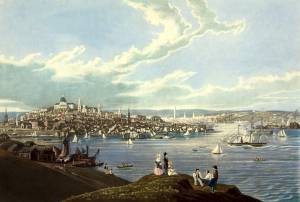
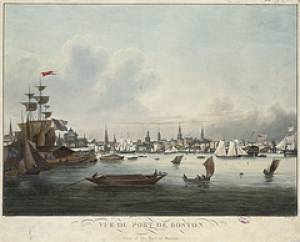

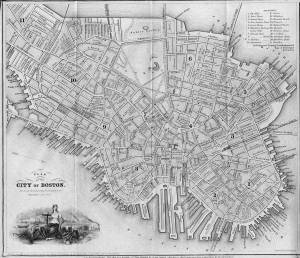
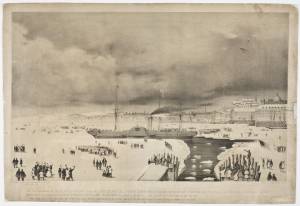

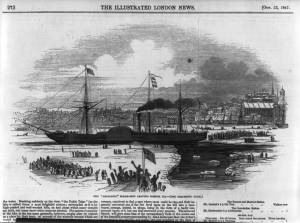
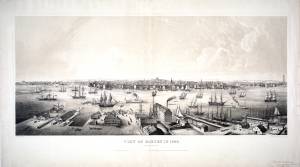
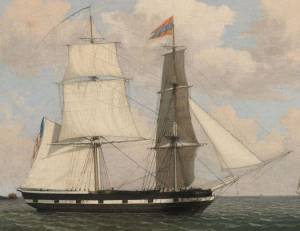

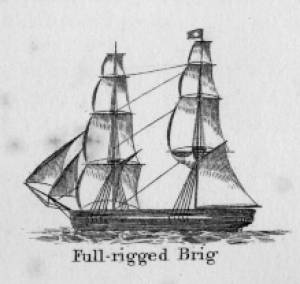

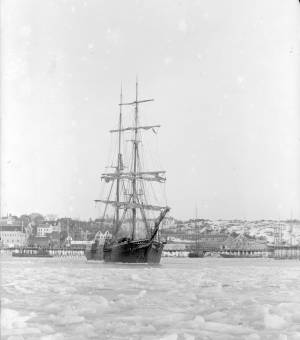

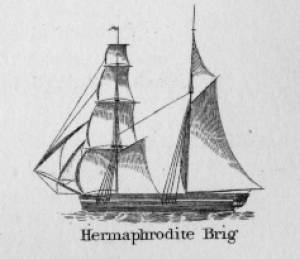

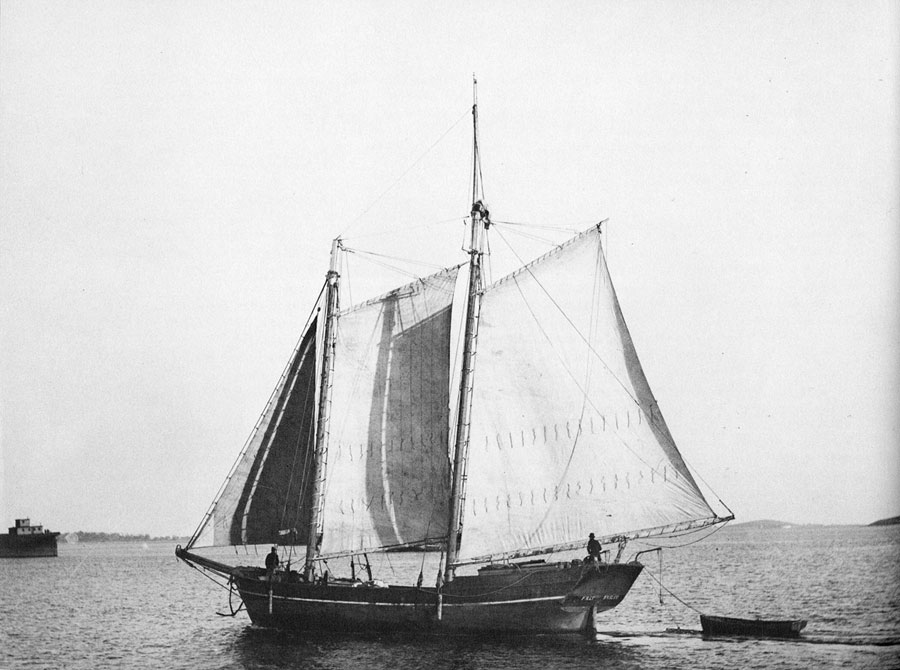
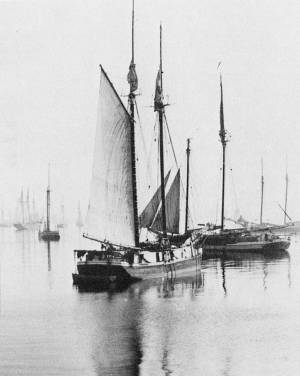


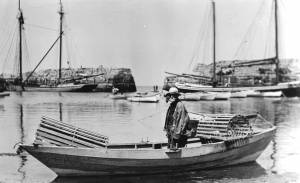




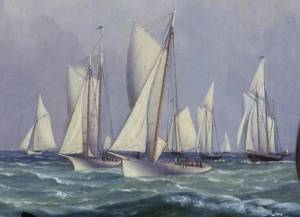
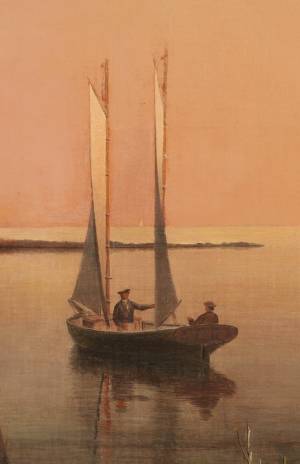



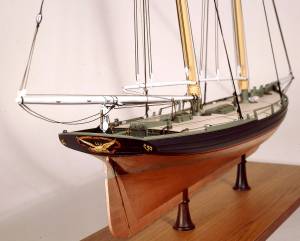


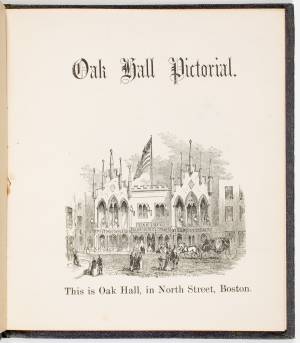
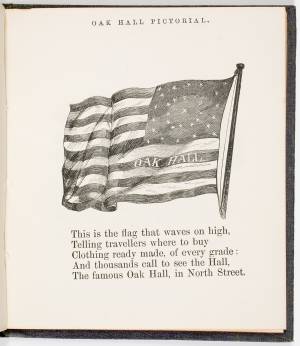




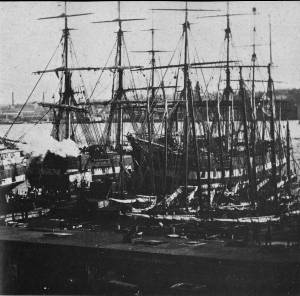
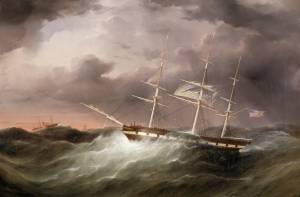
Commentary
Viewed while looking westward, with the sandy peninsula of Hull, Massachusetts, and its Point Allerton monument close abeam, a merchant brig departs Boston for a destination port to the south. Point Allerton marks the southern entrance to Boston Harbor and was commonly used by vessels bound for—or inbound from—southern ports.
In the foreground, a man in the bow of a yawl boat is furling a spritsail, the purpose of this activity being unclear. Beyond is a sloop—possibly a yacht—making good time under mainsail and jib. Astern of the brig is a half brig in the process of setting its fore course. The sail and spar proportions suggest that this vessel was originally a topsail schooner, but was rerigged as a half brig without reproportioning the sails on her foremast. In the far right background is a topsail schooner of more conventional rig and sail proportions.
The brig is not a new vessel. Her hull and rig are conservative in design and her sails are patched and worn. This type of ship was used in coastal trade with distant ports in North and South America (as in Gloucester’s Surinam trade), and her large cabin abaft the main mast indicates passenger accommodations, thus her employment in the packet trade.
Except for her furled main course and inner jib, all plain sail will be set once the fore royal is hoisted. The main course will remain furled while sailing downwind to allow the fore square-sails to draw fully, making steering the vessel less strenuous. The inner jib will also remain furled in this situation as it is blanketed by the fore course and would not add to the driving power of the sail plan. Lane’s attention to these details of ship handling are undoubtedly the reason why experienced sailors and knowledgeable vessel owners were his strongest admirers and patrons.
This painting’s brig bears a strong resemblance to the brig in Brig Off the Maine Coast, 1851 (inv. 241), as well as the half brig in Two Ships in Rough Seas, 1847 (inv. 34). All three vessels share a similar hull geometry, the one in this painting differing in having a simple gammon knee instead of a beakhead with carvings and head rails. Both this work and Two Ships in Rough Seas, 1847 (inv. 34) were painted in 1847, suggesting that the brig we see here was the basis for the brig depicted in the Two Ships painting. The same vessel is used again four years later in Brig Off the Maine Coast, 1851 (inv. 241). This adds to the argument that Two Ships in Rough Seas, 1847 (inv. 34) was a color sketch whose main subject was used selectively for larger works depicting other settings.
– Erik Ronnberg
[+] See More